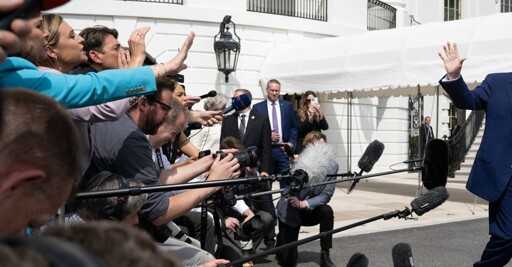Defending mainstream journalism these days is about as appealing as doing PR for syphilis. Nonetheless, here I am. Back in February, Attorney General Pam Bondi invited a group of MAGA influencers to the White House to receive what was billed as “Phase 1” of the government’s files on Jeffrey Epstein, the wealthy sex offender who died in jail in 2019. The 15 handpicked newshounds included Jack Posobiec, promoter of the Pizzagate conspiracy theory; Chaya Raichik, whose Libs of TikTok social-media account itemizes every single American schoolteacher with blue hair and wacky pronouns; and the comedian Chad Prather, performer of the parody song “Beat That Ass,” about the secret to good parenting. Also present was DC_Draino, whose name is a promise to unclog the sewers of the nation’s capital.
The chosen ones duly emerged bearing ring binders and smug expressions—only to discover that most of the information that the government had fed them had already been made public. Several of the influencers have since complained that the Trump administration had given them recycled information. They couldn’t seem to understand why White House officials treated them like idiots. I can help with this one. That’s because they think you are idiots.
[Read: Trump’s Epstein answers are getting worse]
The harsh but simple truth is that powerful people, including President Donald Trump, do not freely hand out information that will make them look bad. If a politician, PR flak, or government official is telling you something, assume that they’re lying to you or spinning or—at best—coincidentally telling you the truth because it will damage their enemies. “We were told that more was coming,” Posobiec complained, but professional commentators should be embarrassed about waiting for the authorities to bless them with scoops. That’s not how things work. You have to go and find things out. Reporters do not content themselves with “just asking questions”—the internet conspiracist’s favored formulation. They gather evidence, check facts, and then decide what they are confident is true. They don’t just blast out everything that lands on their desk, in a “kill ’em all, let God sort ’em out” kind of way.
That’s because some conspiracy theories turn out to involve actual conspiracies, and the skill is separating the imagined schemes from the real ones. Cover-ups do happen. In Britain, where I live, the public has recently learned for certain that a military source accidentally leaked an email list of hundreds of Afghans who cooperated with Western forces, possibly exposing them to blackmail or reprisals. The leak prompted our government to start spending billions to secretly relocate some of the affected Afghans and their families. All the while, British media outlets—which are subject to far greater legal restrictions on publication than their American counterparts—were barred from reporting not only the contents of the leaked list, but its very existence. Several news organizations expended significant time and money getting that judgment overturned in court.
Earlier this month, the government released a memo declaring that the Department of Justice and the FBI had determined that “no further disclosure would be appropriate or warranted” in the Epstein case. Since then, Trump-friendly influencers have struggled to supply their audience’s demands for more Epstein content while preserving their continued access to the White House, which wants them to stop talking about the story altogether. Because these commentators define themselves through skepticism of “approved narratives” and decry their enemies as “regime mouthpieces,” their newfound trust in the establishment has been heartwarming to see.
Some of the same people who used to cast doubts about the government’s handling of the Epstein case are now running that government. “If you’re a journalist and you’re not asking questions about this case you should be ashamed of yourself,” J. D. Vance tweeted in December 2021. “What purpose do you even serve?”
I would be intrigued to hear a response to that challenge from Dinesh D’Souza, who said on July 15 that “even though there are unanswered questions about Epstein, it is in fact time to move on.” Or from Charlie Kirk, who said a day earlier: “I’m done talking about Epstein for the time being. I’m gonna trust my friends in the administration. I’m gonna trust my friends in the government.” Or from Scott Adams, the Dilbert creator, who wrote: “Must be some juicy and dangerous stuff in those files. But I don’t feel the need to be a backseat driver on this topic. Four leaders I trust said it’s time to let it go.” (For what it’s worth, some influencers, such as Tucker Carlson, have refused to accept the Trump administration’s official line that there’s nothing to see here. I’m not alone in thinking this reflects a desire to outflank anyone tainted by, you know, actual government experience when competing for the affections of the MAGA base in 2028.)
For all right-wing influencers’ claims of an establishment cover-up, most of the publicly known facts about the Epstein case come from major news outlets. In the late 2000s, when few people were paying attention, The New York Times faithfully chronicled Epstein’s suspiciously lenient plea deal—in which multiple accusations of sexual assault on teenage girls were reduced to lesser prostitution charges—under classically dull headlines such as “Questions of Preferential Treatment Are Raised in Florida Sex Case” and “Amid Lurid Accusations, Fund Manager Is Unruffled.” After Epstein’s second arrest, the paper reported on how successfully he had been able to rehabilitate himself from his first brush with the law, prompting awkward questions for Bill Gates, Prince Andrew, and other famous faces.
Epstein’s second arrest might not have happened at all without the work of Julie Brown of the Miami Herald. She doggedly reported on how Trump’s first-term labor secretary, Alexander Acosta, had overseen the plea deal when he was a U.S. attorney in Florida. She found 80 alleged victims—she now thinks there might have been 200—and persuaded four to speak on the record. Around the time that Epstein was wrapping up a light prison sentence in 2009, newsroom cuts at the Herald had forced Brown to take a 15 percent pay reduction. Sometimes she paid her own reporting expenses.
[Listen: The razor-thin line between conspiracy theory and actual conspiracy]
Over the past two decades, the decline of classified advertising, along with the rise of social media, has left America with far fewer Julie Browns and far more DC_Drainos. This does not feel like progress. The shoe-leather reporters of traditional newspapers and broadcasters have largely given way to a class of influencers who are about as useful as a marzipan hammer in the boring job of establishing facts. In May, Trump’s press secretary, Karoline Leavitt, scheduled a series of special influencers-only briefings, and I watched them all—surely reducing my future time in purgatory. None of the questions generated a single interesting news story.
In recent days, while MAGA influencers have muttered online about the release of camera footage from outside Epstein’s cell on the night of his death, Wired magazine found experts to review the video’s metadata, establishing that it had been edited, and a section had been removed. Yesterday, The Wall Street Journal—whose conservative opinion pages make its news reporting harder for the right to dismiss—published details of a 50th-birthday message to Epstein allegedly signed by Trump in 2003. The future president reportedly included a hand-drawn picture of a naked woman and told the financier, “May every day be another wonderful secret.” (Trump has described this as a “fake story,” adding: “I never wrote a picture in my life.” In fact, Trump has donated a number of his drawings to charity auctions.)
Legacy news outlets sometimes report things that turn out not to be true: Saddam Hussein’s imaginary WMDs, the University of Virginia rape story. But that’s because they do reporting. It’s easier not to fail when you don’t even try.
We now have a ridiculous situation where influencers who bang on about the mainstream media are reduced to relying on these outlets for things to talk about. Worse, because no issue can ever be settled as a factual matter, the alternative media is a perpetual-motion machine of speculation. MAGA influencers want the truth, but ignore the means of discovering it.
At the heart of the Epstein story is a real conspiracy, as squalid and mundane as real life usually is. The staff members who enabled Epstein; the powerful friends who ignored his crimes; and the prosecutors who downgraded the charges back in the late ’00s. If the Epstein scandal teaches us anything, it is that America needs a dedicated and decently funded group of people whose job is not just to ask questions, but to find answers. Let’s call them journalists.
From The Atlantic via this RSS feed


